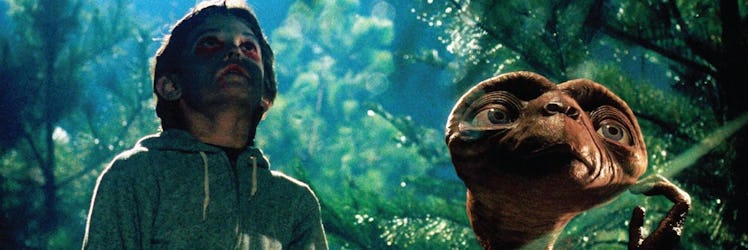SETI’s Top Astronomer On How To Answer The Question ‘Are Aliens Real?’
Even science can't explain ALF.

If you grew up in the era of Close Encounters of the Third Kind, Alien, and E.T. you know that extraterrestrial life is coming to Earth to either a) steal our kids, b) eat our intestines, or c) eat our Reeses Pieces. Seth Shostak, Senior Astronomer at the SETI Institute and recent winner of the Carl Sagan Prize for Science Popularization, says that the answer is really d) none of the above.
Either he was being really coy about the Body Snatchers living among us, or Shostak is telling the truth about finding signs of intelligent life in the universe. He does stress that even though we’re looking at a drop of water in the galactic ocean, the advancement of technology and new understanding of planets can end the search for E.T. in your kid’s lifetime. Here’s how to prepare your sons and daughters for the first contact.
Are We Alone?
When you’re out stargazing with your kids, the question is bound to come up. Are we alone in the universe? In this moment you can either tee up some old episodes of Star Trek (“See son, that’s why you never want to be an ensign on the U.S.S. Enterprise”) or better yet, relay this message from a scientist who has been hunting for aliens most of his life:
“We now know that most of those stars have planets around them. While we haven’t found anything yet, it seems kind of likely that at least some of those planets will have plants, animals, creatures, maybe even creatures that are something like us.” Which leads to the next question…
What Do Aliens Look Like?
“Science doesn’t tell us much about what life would look like,” says Shostak. “If you go to the zoo, you’ll see lots of other Earthlings, but they don’t look much like us. Some of them looks like snakes, some look like fish and some look like giraffes, but they’re all close relatives of ours.” Which is to say don’t put too much stock in the idea that an alien life form is going to be humanoid.
“Most of the life in the universe is probably single-celled. Most of the life on Earth is single-celled. The Earth has had life for 4 billion years, and for the first 3 and a half billion all of it was microscopic. So you can be pretty sure that most of the life in the universe would require a microscope to see.”
How Are We Looking For Life?
There are 3 main ways humans are currently looking for life:
- Sending rockets. “That’s how we look for it on Mars, for example. We send robotic spacecraft to marks with little motorized skateboards to run around the surface of the red planet trying to find life.”
- Looking Through Telescopes. Big observatories are acting like the Trulia of deep space exploration, looking for plants that match the criteria for supporting lifeforms. “Everyone takes the oxygen in our atmosphere for granted,” says Dr. Shostak. “They just assume it’s always been here, but it hasn’t always been here. The oxygen in our atmosphere is a result of plants. If you found oxygen in some other world around a different star, you could say it looks like it has plants.”
- Using Antennas. At the SETI institute they use big antenna arrays to listen in on signals that are being broadcast into space. We’ve also sent out a few of our own pings through the ionosphere as a message to other races. So far, nobody has returned our calls.
You’re More Frightened of Aliens Than Your Kid
“I’ve never had any kid that was frightened by this idea,” says Shostak. “Kids are naturally interested in extraterrestrials for the same reason that they’re interested in dinosaurs. You’re hardwired to be interested in the behavior of predators. Anything with big teeth we find interesting. If you’re not interested in that you’re probably not in the gene pool anymore. I think the same thing applies to other creatures that might be competitors.”
What To Say About Sci-Fi Movies
Movies aren’t in the science education business. If they were, Avatar wouldn’t have made $2 billion. “When the science is substantially bonkers, I don’t think it’s a bad thing.” says Shostak, who says that despite the implausibility that an entire alien race can be brought down by Jeff Goldblum and a MacBook, he’ll get tickets to Independence Day 2 like the rest of us. “If you’ve studied the history of the American West, most Westerns don’t make sense. That doesn’t mean I don’t enjoy the film.”
A Few Notes On … Probing
What’s SETI’s position on all the people who say they’ve been tractor-beamed from their pickup trucks and intergalactically sodomized? “If there was some truth to aliens buzzing the skies or hauling people out of their homes, that would be really interesting. But the evidence is extremely poor. One-third of the American public believes in ghosts, too, but you don’t find ghosts at American Museum of Natural History. It’s not because the public wouldn’t be interested, it’s because there’s just no science in it.”
How To Encourage Junior Alien Hunters
Whatever gets your kid into learning more about astronomy and the search for intelligent life is fair game. “I grew up on Star Trek and always enjoyed it, even though the stories are largely bonkers. The things that affected me most are movies and television shows and those got me to go to the local library, where I’d spend a lot of time there just looking at books about science,” says Shostak. Because at the end of the day, Captain Kirk was a role model for exploring new life and new civilizations — not just exploring Orian women.
This article was originally published on